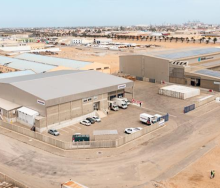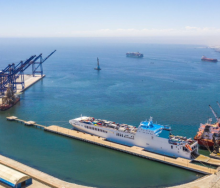A cargo plane operated by DHL crashed near Vilnius Airport, Lithuania, early Monday morning, killing one crew member and injuring three others.
The aircraft, en route from Leipzig, Germany, skidded into a residential area before bursting into flames, however no injuries have been reported among local residents, according to Associated Press.
The cause of the crash remains under investigation.
Lithuanian authorities confirmed that the Boeing 737 had crashed at 05:30 local time, just over a kilometre from the airport. The aircraft, operated by Madrid-based contractor Swiftair, was carrying four crew members: a Spanish national who died, and three others — a German, Lithuanian, and another Spaniard — who sustained injuries.
DHL, in a statement, referred to the incident as a “forced landing” but provided no further details.
In light of the escalating conflict between Russia and Ukraine, Lithuanian Prime Minister, Ingrida Šimonytė, urged caution against speculation, emphasising that investigators required time to determine the cause of the crash.
She expressed gratitude that no civilians had been harmed, despite the crash occurring in a residential area, noting that only minor damage to a nearby house had been sustained.
Authorities confirmed that the flight data recorder, or ‘black box’, would be key to uncovering the events leading to the crash. Lithuanian defence minister Laurynas Kasčiūnas said no external factors had been detected that could have caused the crash but added that further interviews with surviving crew members would be necessary to understand what had transpired inside the aircraft.
German authorities have also joined the investigation, sending experts from the Federal Bureau of Aircraft Accident Investigation to assist.
Although Lithuanian officials stressed that there was no evidence of foul play, one line of inquiry is whether sabotage could have been involved, particularly given recent suspicions of Russian interference in incidents across Europe. Lithuanian intelligence chief Darius Jauniškis said the possibility of terrorism could not be ruled out, though he cautioned against premature conclusions.
German foreign minister Annalena Baerbock, speaking at a meeting in Italy, said the crash had followed other recent incidents of suspected sabotage, including damage to Baltic Sea data cables and fires in cargo hubs in Germany and England. Baerbock said the situation highlighted the volatility of the current geopolitical climate.
Witnesses reported dramatic scenes as the aircraft descended and exploded into a fireball. A local resident, identified only as Svaja, described seeing a bright light followed by an explosion, initially fearing the outbreak of war. Footage from a surveillance camera showed the aircraft descending normally before it vanished behind a building and erupted in flames.
Rescue teams worked to contain the fire and secure the site, with fragments of the plane, painted in DHL’s signature yellow, scattered across the area. The damaged house was evacuated and residents were unharmed.
Flight-tracking data from FlightRadar24 showed the aircraft turning north of the airport and lining up for landing before crashing about 1.5 kilometres from the runway. Weather conditions at the time were near freezing, with cloudy skies and moderate winds.
The aircraft, a 31-year-old Boeing 737, is considered an older airframe but not unusual for cargo operations. Experts will assess whether the aircraft’s age played any role in the crash.
Lithuanian officials reassured the public that rescue operations and investigative efforts were progressing efficiently. Šimonytė urged patience, stressing that only a thorough investigation could provide clarity on the incident.













